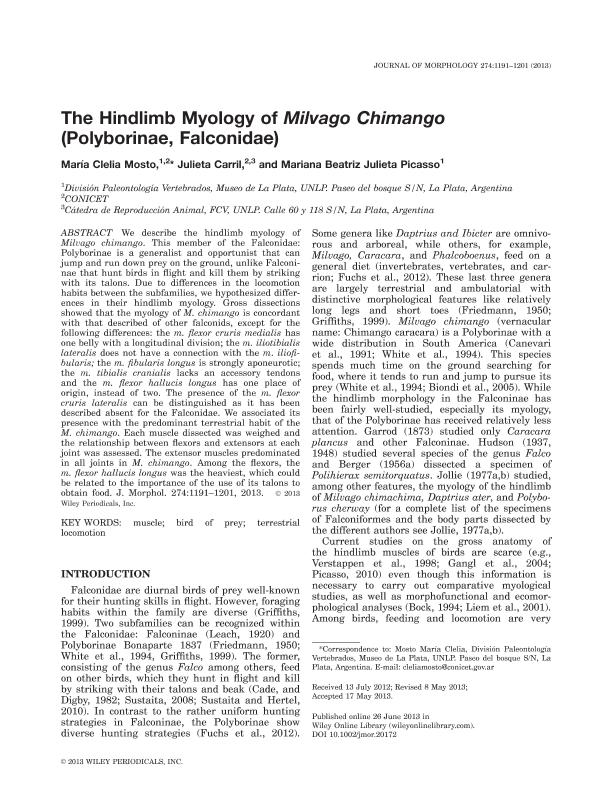Mostrar el registro sencillo del ítem
dc.contributor.author
Mosto, María Clelia

dc.contributor.author
Carril, Julieta

dc.contributor.author
Picasso, Mariana Beatriz Julieta

dc.date.available
2017-10-24T18:35:47Z
dc.date.issued
2013-06
dc.identifier.citation
Mosto, María Clelia; Carril, Julieta; Picasso, Mariana Beatriz Julieta; The hindlimb myology of Milvago chimango (Polyborinae, Falconidae); Wiley; Journal of Morphology; 274; 10; 6-2013; 1191-1201
dc.identifier.uri
http://hdl.handle.net/11336/27009
dc.description.abstract
We describe the hindlimb myology of Milvago chimango. This member of the Falconidae: Polyborinae is a generalist and opportunist that can jump and run down prey on the ground, unlike Falconinae that hunt birds in flight and kill them by striking with its talons. Due to differences in the locomotion habits between the subfamilies, we hypothesized differences in their hindlimb myology. Gross dissections showed that the myology of M. chimango is concordant with that described of other falconids, except for the following differences: the m. flexor cruris medialis has one belly with a longitudinal division; the m. iliotibialis lateralis does not have a connection with the m. iliofibularis; the m. fibularis longus is strongly aponeurotic; the m. tibialis cranialis lacks an accessory tendons and the m. flexor hallucis longus has one place of origin, instead of two. The presence of the m. flexor cruris lateralis can be distinguished as it has been described absent for the Falconidae. We associated its presence with the predominant terrestrial habit of the M. chimango. Each muscle dissected was weighed and the relationship between flexors and extensors at each joint was assessed. The extensor muscles predominated in all joints in M. chimango. Among the flexors, the m. flexor hallucis longus was the heaviest, which could be related to the importance of the use of its talons to obtain food.
dc.format
application/pdf
dc.language.iso
eng
dc.publisher
Wiley

dc.rights
info:eu-repo/semantics/openAccess
dc.rights.uri
https://creativecommons.org/licenses/by-nc-sa/2.5/ar/
dc.subject
Muscle
dc.subject
Bird of Prey
dc.subject
Terrestrial Locomotion
dc.subject.classification
Bioquímica y Biología Molecular

dc.subject.classification
Ciencias Biológicas

dc.subject.classification
CIENCIAS NATURALES Y EXACTAS

dc.title
The hindlimb myology of Milvago chimango (Polyborinae, Falconidae)
dc.type
info:eu-repo/semantics/article
dc.type
info:ar-repo/semantics/artículo
dc.type
info:eu-repo/semantics/publishedVersion
dc.date.updated
2017-10-19T20:32:25Z
dc.identifier.eissn
1097-4687
dc.journal.volume
274
dc.journal.number
10
dc.journal.pagination
1191-1201
dc.journal.pais
Estados Unidos

dc.journal.ciudad
Hoboken
dc.description.fil
Fil: Mosto, María Clelia. Universidad Nacional de la Plata. Facultad de Ciencias Naturales y Museo. División Paleontología Vertebrados; Argentina. Consejo Nacional de Investigaciones Científicas y Técnicas; Argentina
dc.description.fil
Fil: Carril, Julieta. Universidad Nacional de La Plata. Facultad de Ciencias Veterinarias; Argentina. Consejo Nacional de Investigaciones Científicas y Técnicas; Argentina
dc.description.fil
Fil: Picasso, Mariana Beatriz Julieta. Universidad Nacional de la Plata. Facultad de Ciencias Naturales y Museo. División Paleontología Vertebrados; Argentina. Consejo Nacional de Investigaciones Científicas y Técnicas; Argentina
dc.journal.title
Journal of Morphology

dc.relation.alternativeid
info:eu-repo/semantics/altIdentifier/doi/http://dx.doi.org/10.1002/jmor.20172
dc.relation.alternativeid
info:eu-repo/semantics/altIdentifier/url/http://onlinelibrary.wiley.com/doi/10.1002/jmor.20172/abstract
Archivos asociados
